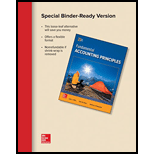
Concept explainers
Variance:
Variance is the difference between the actual cost and budgeted cost for particular level of activity. It is computed by deducting the budgeted cost from the actual cost of the production.
Direct Material Cost Variance:
The difference between the actual cost incurred on the direct material and the budgeted cost expected to be incurred is called the direct material cost variance. It can either calculated by deducting the budgeted cost from the actual cost or adding the direct material price variance and direct material quantity variance.
Direct Labor Cost Variance:
The variance between the actual labor cost incurred and the budgeted labor cost is termed as direct labor cost variance. It can be computed by deducting the budgeted labor cost from the actual cost. On the contrary, it can also be ascertained by adding the direct labor rate variance and direct labor efficiency variance.
Controllable Variance:
The overall variance which comprises of variable
Volume Variance:
The variance which arises due to difference in the budgeted level of activity and the actual level is called volume variance. The sole reason for this kind of variance is the variation in the level of activity.
To determine:
Computation of these variances:
(a) Variable overhead spending and efficiency
(b) Fixed overhead spending and volume
(c) Total overhead controllable variance
Want to see the full answer?
Check out a sample textbook solution
Chapter 23 Solutions
Loose Leaf for Fundamental Accounting Principles
- Please explain the correct approach for solving this general accounting question.arrow_forwardZebrix Ltd. has an inventory period of 55 days, an accounts receivable period of 10 days, and an accounts payable period of 6 days. The company's annual sales are $208,400. How many times per year does the company turn over its accounts receivable?arrow_forwardLika company issues 2,000 shares of $10 par value common stock for $25 per share. What amount should be credited to the Common Stock account and to the Additional Paid-in Capital account?arrow_forward
- Can you help me solve this general accounting question using the correct accounting procedures?arrow_forwardCan you solve this general accounting question with accurate accounting calculations?arrow_forwardPlease provide the correct answer to this general accounting problem using accurate calculations.arrow_forward
- I need help solving this general accounting question with the proper methodology.arrow_forwardI need help finding the accurate solution to this general accounting problem with valid methods.arrow_forwardPlease provide the answer to this financial accounting question using the right approach.arrow_forward

 AccountingAccountingISBN:9781337272094Author:WARREN, Carl S., Reeve, James M., Duchac, Jonathan E.Publisher:Cengage Learning,
AccountingAccountingISBN:9781337272094Author:WARREN, Carl S., Reeve, James M., Duchac, Jonathan E.Publisher:Cengage Learning, Accounting Information SystemsAccountingISBN:9781337619202Author:Hall, James A.Publisher:Cengage Learning,
Accounting Information SystemsAccountingISBN:9781337619202Author:Hall, James A.Publisher:Cengage Learning, Horngren's Cost Accounting: A Managerial Emphasis...AccountingISBN:9780134475585Author:Srikant M. Datar, Madhav V. RajanPublisher:PEARSON
Horngren's Cost Accounting: A Managerial Emphasis...AccountingISBN:9780134475585Author:Srikant M. Datar, Madhav V. RajanPublisher:PEARSON Intermediate AccountingAccountingISBN:9781259722660Author:J. David Spiceland, Mark W. Nelson, Wayne M ThomasPublisher:McGraw-Hill Education
Intermediate AccountingAccountingISBN:9781259722660Author:J. David Spiceland, Mark W. Nelson, Wayne M ThomasPublisher:McGraw-Hill Education Financial and Managerial AccountingAccountingISBN:9781259726705Author:John J Wild, Ken W. Shaw, Barbara Chiappetta Fundamental Accounting PrinciplesPublisher:McGraw-Hill Education
Financial and Managerial AccountingAccountingISBN:9781259726705Author:John J Wild, Ken W. Shaw, Barbara Chiappetta Fundamental Accounting PrinciplesPublisher:McGraw-Hill Education





